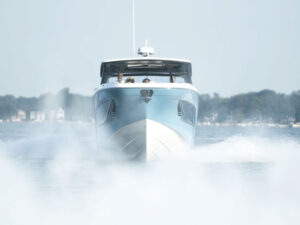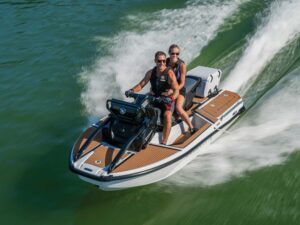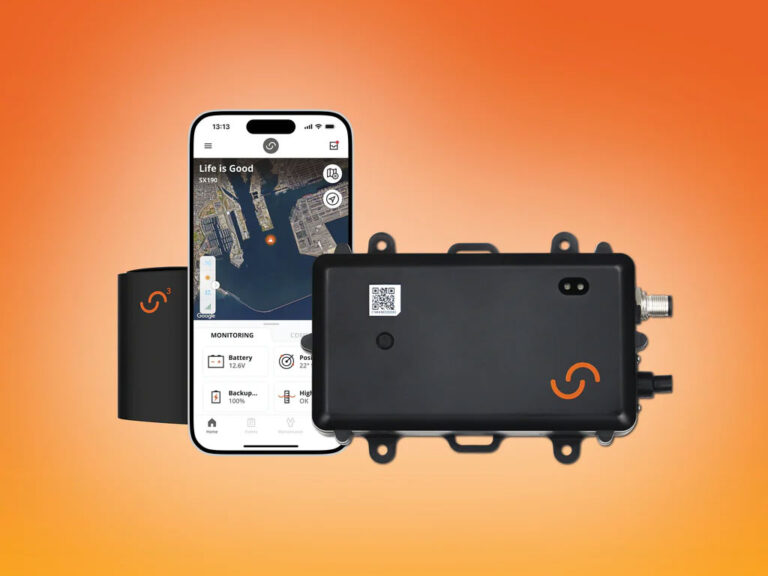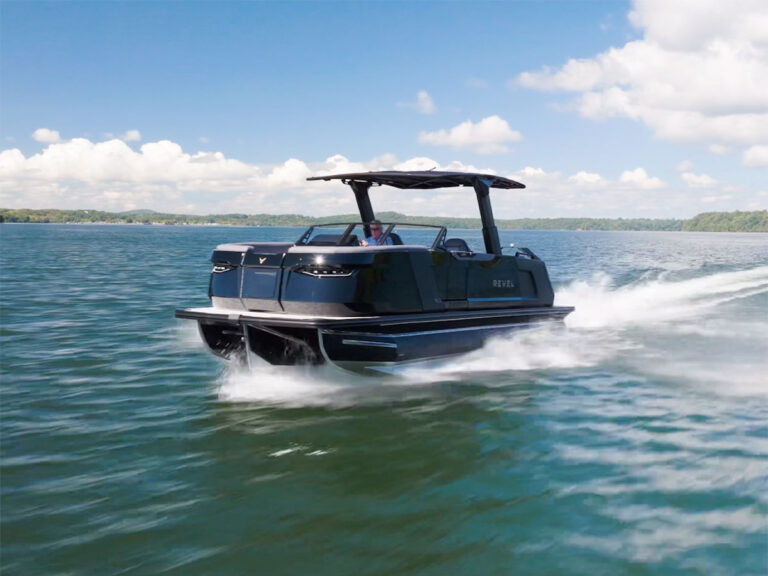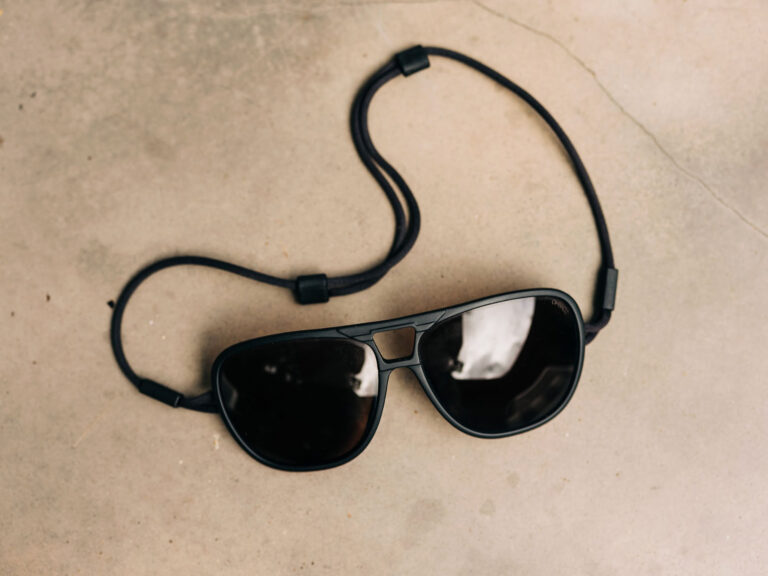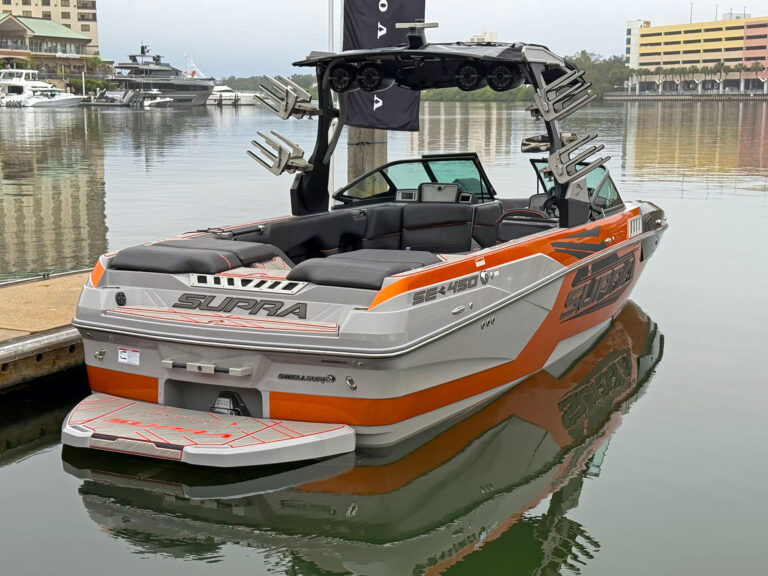
Despite the trademark high winds of Chicago, the afternoon summer sun beat down on my face while out on Lake Michigan. Squinting while wearing sunglasses, I fixed my eyes on the buoys as I navigated a 75-foot yacht. During my day of instruction with Capt. Kelly Gordon, she allowed me to take the wheel of the largest vessel I’d ever run in nine years of boating.
Over the last year or so, there has been quite an influx of boaters joining the community. This influx includes seasoned participants and novices, popping up in major port cities like Newport, Rhode Island; Miami, Florida; and Chicago, where Gordon mans a privately owned 75-foot Sunseeker. Gordon often catches these new boat owners trying to tackle the cerulean waters of Lake Michigan, as well as the locks. While a female yacht captain might be a rare sight on the water, Gordon has seen the best and worst of the influx, and too often, she witnesses couples having arguments, detracting from what should be a pleasurable experience. I know this all too well, and early on, my time on the water with my fiancé was quite the test. He had more experience than me, and it took quite some time for him to relinquish control and allow me to be his first mate.
Gordon, who splits time between Chicago and Fort Lauderdale, would love to see more women on the water, and she believes a good starting point is for couples to learn how to work together. Boating is the perfect opportunity to build trust with your partner, and it offers a proud collaborative effort that can help build a strong bond. It’s also a sexy pastime. A good place to start, Gordon believes, is including your partner in the basics.
“This season, a lot of boats have been sold, typically anywhere from a 30- to 50-foot range. I also see quite a few couples renting boats, and there is a lot of yelling,” she tells me. “I can’t stress enough how important communication is for safety and success on the water.”
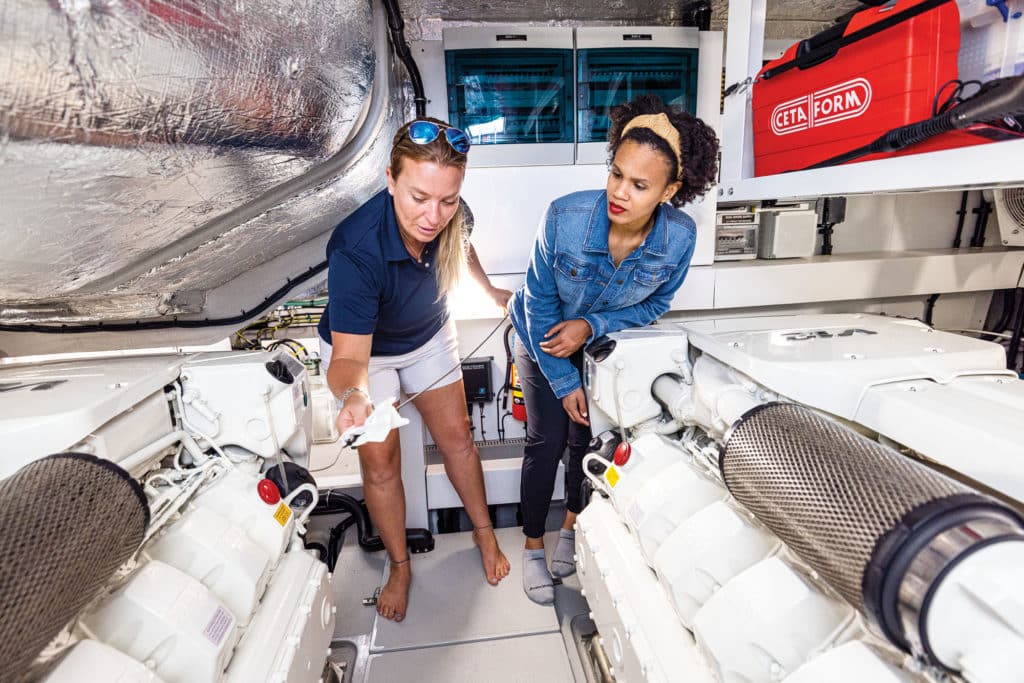
Starting Points
I get my first taste of how a good captain operates by watching Gordon and her first mate, Gianna Mesi. They communicate with few words and have developed a rhythm that works for them. From the moment I step on the Sunseeker, I see this. While Gordon takes me into the engine compartment, Mesi is outside checking the fenders and disconnecting the water line. I wonder if this process was always this smooth, or if I’m watching the result of years of cooperation.
Launching can go more smoothly when tasks are delegated. Gordon likes to start her departure with fluid checks. “For your pre-departure engineering checks, you will check on the fluids in the main engines, as well as the antifreeze level, and the oil in the genset.” Gordon also checks the oil in the transmissions, then she glances at all of the hose clamps to make sure there are no leaks and that nothing looks loose. She also checks the through-hull fittings for cracks, water stains, and any other signs that they need to be replaced. Last, she looks for clogged strainers. If they are clogged, then the basket can be pulled out and cleaned.
Once these tasks are complete and she’s ready to launch, she switches power from the shore power to the generator. On the Sunseeker, that is as easy as pushing a button on a screen because it has a smart genset. “The genset senses when you start the generator, and it’ll switch from shore power to generator power,” Gordon explains. “Once you hear the air kick back on, the generators have taken over.” After I pushed the “power off” button, I listened as the air conditioners shut down, then whizzed back on.
For a boat without a smart genset, Gordon recommends turning off heavier loads, like the air conditioning. Then you’d disconnect shore power and fire up the generator.
Launching Tasks
- Check engine oil, antifreeze, transmission and genset, if applicable.
- Check hose clamps for looseness or drips.
- Make sure strainers aren’t clogged.
- Switch from shore power to generator power, if applicable.
- File a float plan to let others know where you’ll be.
- Do a safety review with any guests.
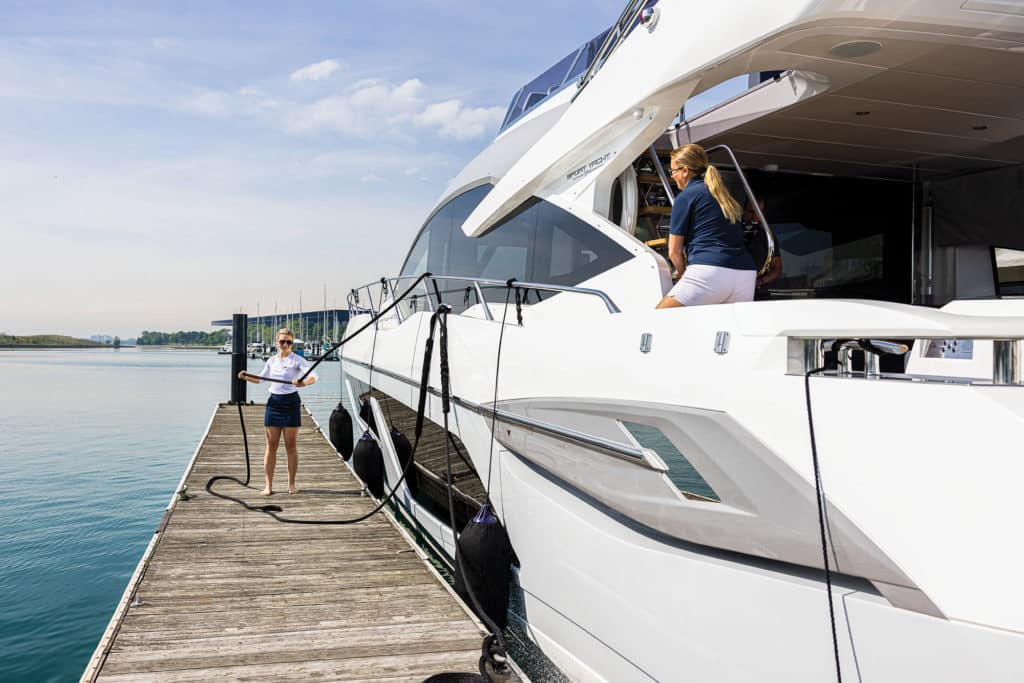
A good idea for couples would be for one to handle some of the checks, like pulling the dipsticks in the engine, and for one to be on the dock, ready to untie lines, pull up fenders, and disconnect the shore-power cords. With one partner on the dock, there are more eyes to ensure a smooth departure. Aboard this boat, Mesi handles the dockside tasks, working in sync with her captain and calling out commands that they both understand. “She and I have been working together for about three years now, so we’re getting to the point where she can just read my body language, look at my face, and she’ll know what it is I want, and I think ultimately that’s the goal to get to as a couple. There’s never any yelling or getting loud.” Before officially launching, the crew should all do a safety check before departure. That includes making sure there is a life vest for every passenger.
Gordon also files a float plan prior to leaving, then checks in with that person upon return.
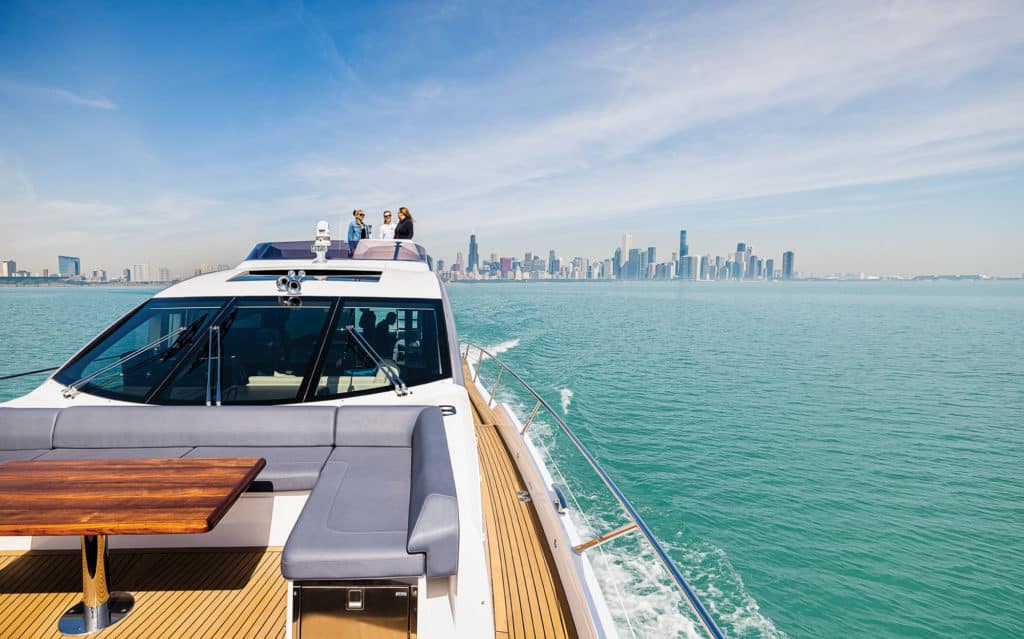
Cool Runnings
As we embarked, I was reminded that time on the water is for pleasure. Gordon and I set out from the marina at the flybridge, which is where she has the best view of her surroundings. Once we were out of Burnham Harbor, Mesi joined us. After all of the times they’ve been out on Lake Michigan, they were still impressed by the miles of blue reminiscent of the Bahamas. I was thinking, All of this beauty in the middle of the US?
As we encountered some boat traffic, Gordon informed me that boats with limited maneuverability have the right of way. “Unfortunately, too many boaters do not understand the right of way. So, I drive defensively.” Aggressive driving is just as bad, if not worse, on the water. A second set of eyes helps, and the pair watched for other vessels getting too close.
“When you are bigger, you must understand that you can cause more harm to others,” Gordon adds. “Being aware of your surroundings and being patient with novice boaters is so important.”
Still, captains can’t ignore the increase in accidents over the last year, which also coincides with the influx of new boaters. “Again, I want to emphasize the importance of communication,” Gordon says. “The more hectic it gets, the calmer I am, and that’s kind of a place you want to be yourself.”
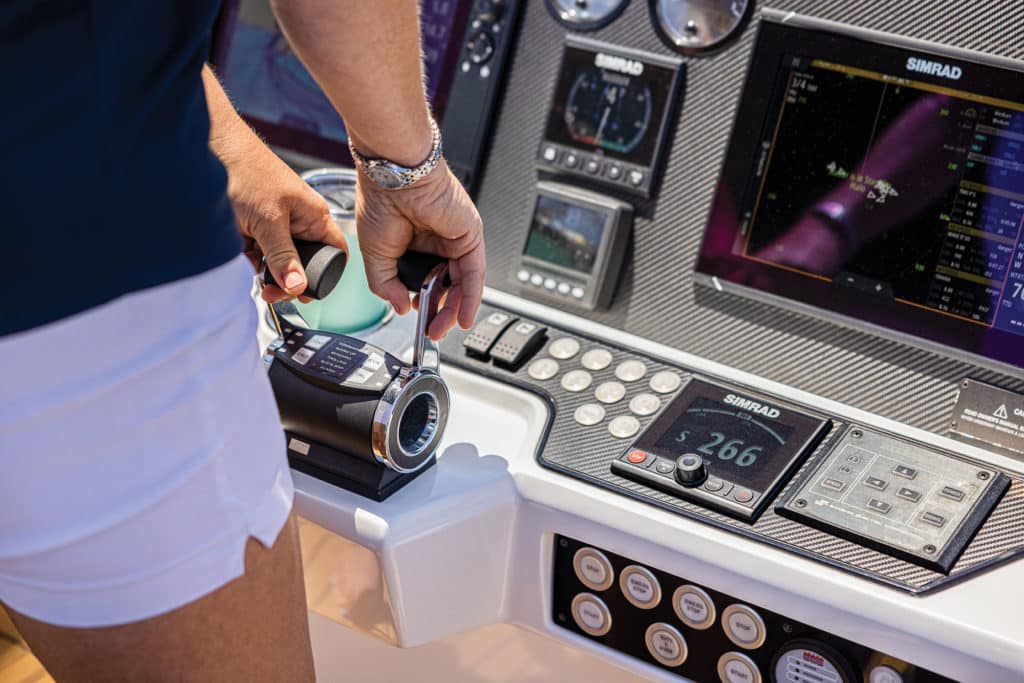
One task is adjusting your radar, but also not being overly reliant on it. “Remember that radar doesn’t pick up every target, so you always have to maintain a proper lookout,” Gordon warns. “My eyeballs are constantly scanning the chart plotter and radar. I look at my dash, and then I look at what’s in front of me, and I just continually go through that cycle. I think a lot of folks get so reliant on the technology that they actually forget to look out the windshield in front of them.”
She recommends adjusting the radar in case of rain or choppy conditions, as well as high-traffic days. This is because it can also protect you in case a smaller vessel, like a sailboat, is without radar and doesn’t show up on your screen. If you have the capability, use a split screen for a close-up radar and one farther out. Fiberglass boats are also sometimes not picked up.
Cruising Tasks
- Adjust radar settings and scan it frequently.
- Don’t rely solely on your radar, your chart plotter or other electronics for what’s happening on the water.
- Keep your eyes scanning the water at all times.
Stopping Time
After a short cruise on the stunning waters of lower Lake Michigan, Gordon decided to demonstrate another crucial yet overlooked boating skill: Properly dropping anchor. Even with today’s modern technology found on most large boats, specifically a windlass, anchoring is not as simple as finding a good spot and hitting a button. The anchoring process starts by pointing your bow into the wind before dropping. The boat will probably blow backward, and facing the wind will ensure that it holds.
Gordon notices many boaters making one major mistake. “I see people having trouble dragging because they don’t put out enough chain,” she says. “Proper scope for anchoring is 7-to-1. So you want seven times the chain out as what the water depth is now, and in heavier winds, you’re going to need a little more chain.” For example, if the boat is in 10 feet of water, you’d need about 70 feet of anchor line.
Gordon’s anchor lessons came from a senior captain. Another piece of advice he gave her: In a crowded anchorage, to avoid too much swing, choose a 5-to-1 ratio. “You can never go wrong with 7-to-1, though,” she explains. After she drops anchor, she pulls back just a touch so that the line isn’t too long. For temporary anchorage for swimming, she still recommends 7-to-1. In a storm or rough seas, you might have to expand your scope to hold. If anyone will be getting into the water, you must have flags alerting other boats.
For manual anchors, Gordon recommends the captain assign a mate to drop and set it if possible so that the captain can maintain control of the boat. Don’t kill the engines until you’re sure the anchor is set securely.
Set It Right
- Try to anchor upwind if at all possible.
- Use a 7-to-1 anchor scope under typical circumstances, and make sure there’s enough chain to prevent anchor drag.

Locked and Loaded
Gordon also gave us a lesson on navigating channel locks, something I’ve never encountered back home in southern New Jersey and Philadelphia. But there’s one at the entrance of the Chicago River, and it offered an opportunity to show a scenario encountered by many boaters around the country. Before we entered the lock, Mesi prepared us by giving everyone a life jacket, which must be worn as you lock-through.
There’s an order for who gets to lock-through first. “Commercial traffic has priority, then government traffic, then we’re last since we’re recreational,” Gordon explains. She pointed to the traffic light and said that yellow allows priority traffic. We’d have to wait for the green to enter.
When arriving, a sweet border collie greeted us and gave us the signal to enter. Well, the dog’s job was actually to chase away birds, but she worked overtime at the lock operator’s side.
In locks where it is necessary to tie off while they raise and lower the water levels, make sure you have proper fenders and your own dock lines just in case. It’s also recommended to have some long-handled boat hooks to retrieve your lines after the water raises or lowers.
Locking Tips
- Life jackets are mandatory.
- Commercial and government vessels have priority, and recreational boaters go last.
- Bring fenders, and have your own lines and boat hooks.
- Abide the lockmaster’s guidance.

Bringing it Home
After an incredible day on the water, Gordon let us know it was time to head home. As we made our way back to the marina, she mentioned that sometimes the end of the day is actually the toughest.
Docking can be the ultimate test for couples or new boaters, especially if they are taking out friends who provide distractions. We’ve all been there. Everyone is loud and the music is bumping, so hypervigilance is necessary to keep everyone safe and to avoid any damage to your boat. Developing a docking strategy is ideal. Gordon says the best thing one can do is practice. “Find someone who is seasoned, who you’re comfortable with, and maybe even ask for lessons. There’s nothing wrong with that. There are plenty of captains who offer that service,” she advises.
Gordon encourages preparing for docking prior to takeoff. Figuring out where you’ll keep your fenders and lines will make tying up much more seamless. Some prefer to leave at least one line behind to use to catch the boat in high winds.
As Gordon slowly pulled into the marina, then close to the slip, Mesi began calling out distances from the dock to the swim platform and to the port side, as well as the pilings separating the Sunseeker from its neighbor on the starboard side. “Three feet!” Mesi yells. Then, “One foot!”
I’d never thought to shout distances or anything other than “You’re too close!” or “You’re going to hit the dock!” (Don’t judge me.) But hearing their communication enlightened me.
Gordon adjusts the throttles and pays attention to which direction the marina flags are blowing. “You really need to check and see what your winds and currents are doing so that you know how to compensate,” she says. “When I come in, I always look for a flag to see in what direction I’m going to get blown.” Many people cut off their boats when pulling into the slip, but Gordon strongly recommends keeping the boat running until you are tied up. “Otherwise, you won’t have any control over the boat,” she says.
After Gordon flawlessly settled the boat into its slip, Mesi worked quickly to secure it with the lines and fenders. And with that, we were home safe and sound. Personally, I learned much from my day that I’m going to take to my home waters. If nothing else, on the water it’s vital to remember: Teamwork is dreamwork.
Docking Tasks
- Practice before taking your boat out for the first time.
- Develop a system with your partner that works and that you both understand.
- Compensate for wind direction and current.


